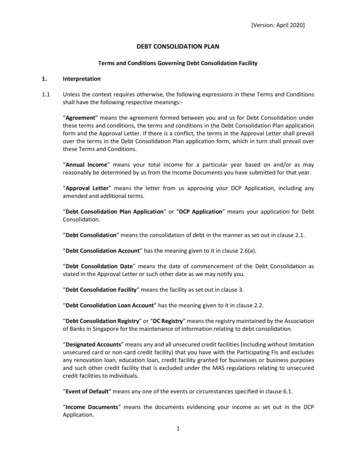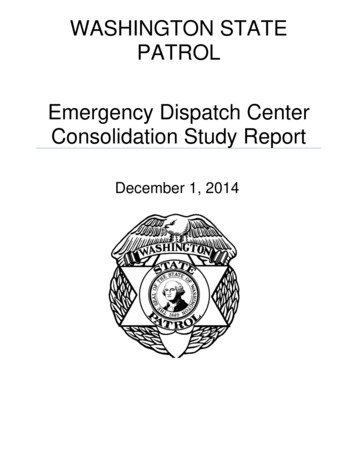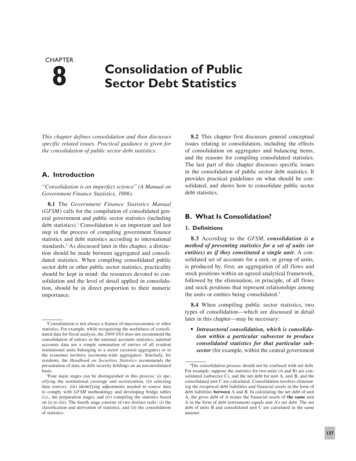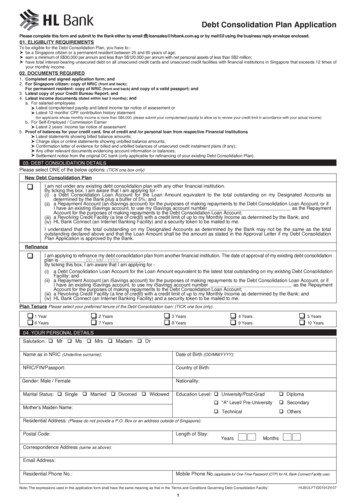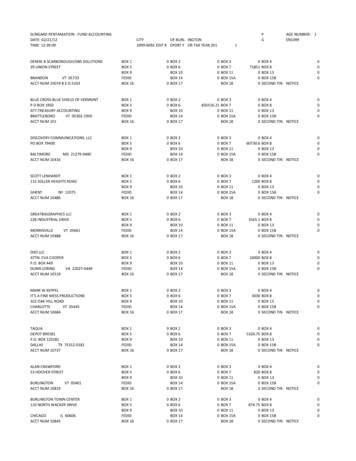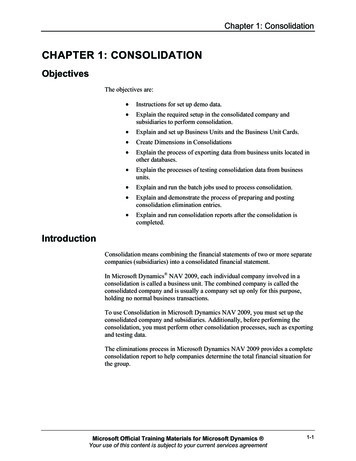
Transcription
Instruction Sheet 700019870Issue 7, May 2013SYSTIMAX Solutionswww.commscope.comSYSTIMAX M224CPN Low-Profile 24-PortConsolidation Point BoxInstallation and Cabling InstructionsGeneralThe M224CPN low profile consolidation box provides a distribution point for data and telecommunicationssignals throughout a work area environment. The low profile of the box permits it to be installed in a variety ofplaces such as under floors, limited space closets, inside paneled furniture, on walls in plain view, and onshelves. The box can be mounted, with additional support, to single- or dual-gang electrical type boxes. For bestresults, the surface the box rests on or is mounted to should be flat. The box measures approximately 8 inches(203mm) by 12 inches (305mm) by 1-1/2 inch (38mm) and is available in black, ivory, white, and gray.The box utilizes four removable panels that can accommodate a variety of copper and fiber based connectors.Each panel will hold up to six connectors each. The box has a capacity of 24 dual SC connectors, single SC connectors, dual LC connectors, ST connectors, M-series type copper connectors, BNC connectors, F-typeconnectors, or any combination thereof. Connector types can be mixed and matched within the box by using twodifferent panels. The M-series panel has the most variety in connector options; it accommodates all but the dualSC connectors. Three fiber optic splice organizers are available which will accommodate fusion, mechanical, or mass fusion splices. The M224CPN consolidation box is part of the SYSTIMAX SCS family of products.Ordering information is listed below:Material IDDescription700016462M224CPN low profile 24-port consolidation point box, black700016470M224CPN low profile 24-port consolidation point box, ivory700016488M224CPN low profile 24-port consolidation point box, white700016496M224CPN low profile 24-port consolidation point box, grayThis product is covered by one or more of the following U.S. patents or their foreign equivalents:5,923,807. 2013 CommScope, Inc. All rights reservedPage 1 of 16
700019870Instruction Sheetwww.commscope.comFully Populated M224CPN Consolidation Point BoxHow to Contact Us To find out more about CommScope products, visit us on the web at http://www.commscope.com/ For technical assistance: -Within the United States, contact your local account representative or technical support at1-800-344-0223. Outside the United States, contact your local account representative orAuthorized Business Partner.-Within the United States, report any missing/damaged parts or any other issues toCommScope Customer Claims at 1-866-539-2795. Outside the United States, contact yourlocal account representative or Authorized Business Partner.CAUTIONS: All cabling that connects to this equipment must meet applicable local and national building codes andnetwork cabling standards for communications cable.Install this unit according to the enclosed instructions only using supplied or recommended mountinghardware. Read and understand all warnings.Never install this product during a lightning storm. There is a remote risk of electrical shock fromlightning.Install only approved devices in this unit.Never install cable, connectors, or jacks in a wet location unless they are specifically designed for thatpurpose.Never touch uninsulated, live communication wires or terminals. They should be disconnected first.This unit cannot support the weight of long cables. Additional cable support is required.Do not look directly into the end of a fiber optic cable or connector without it being disconnected from alight source. Serious eye damage can occur.Exercise caution in terminating fiber optic cable. Fibers are sharp and can penetrate skin or eyes. Wearproper eye and skin protection and safely dispose of any fiber pieces in a hard-sided, sealed container.Page 2 of 16
www.commscope.com700019870Issue 7, May 2013Tools Required Screwdrivers—phillips andflatheadLevelPliers and/or channel locks Electric drill w/ 3/16-inch(4.8mm) bitUtility cutter or knifeWire cutters Harris-dracon D impact tool Measuring tapePencil and/or pen Parts ListVerify parts against the parts list below:Additional Parts Required Four No. 6 screws to secure base to a flat surface.Optional Kits AvailableMaterial IDBlackIvoryWhiteGrayM-series panel kit—includes four Mseries panels of one al SC panel kit—includes FOSFiber optic spool kit—includes twofiber optic spools 700016553 Part No.DescriptionM224MSPPage 3 of 16
700019870Instruction Sheetwww.commscope.comDevices, Other Equipment Compatible with M224CPN BoxPart No. DescriptionM-series modular information outletsM20APDust covers for unused jack openings (quantity of 100)M81ST-BFiber coupler—single STM81SC-BFiber coupler—single SCM81LC-029Fiber coupler—dual LCM81C-BCoaxial video coupler—F connectorM81BNC-BBayonet-type connector (BNC) coaxial coupler—BNC connectorM81Modular blanks1AF1-16LG1AM1-12LGD182842Fusion splice organizer—stores 16 splices (quantity of 10)Mechanical splice organizer—stores 12 splices (quantity of 10)Mass fusion organizer—stores six splices (quantity of 12)ColorAvailable in a varietyof colorsWhiteGrayIvoryBlackEach equipped w/four collars—white,gray, ivory, and blackEach equipped w/ aclear collarEach equipped w/four collars—white,gray, ivory, and blackEach equipped w/four collars—white,gray, ivory, and blackWhiteGrayIvoryBlackWhiteWhiteWhiteDescription of M224CPN BaseThe following drawing shows the M224CPN base and identifies its various features.Page 4 of 16Material ID 06837222106837206105356562105356570107369985
www.commscope.com700019870Issue 7, May 2013Step 1 Install Base UnitThese pages cover three types of installation: Install Base on a Flat Surface (No Electrical Box) Install Base on a Single-Gang Electrical Box Install Base on a Dual-Gang Electrical Box.Note: The four No. 6-32 by 1-1/4 inch (32mm) screws furnished with this kit are for mounting the base to asingle-gang or dual-gang electrical box. Due to the wide range of surfaces the base may be secured to, noadditional mounting hardware is included and will need to be obtained locally.Install Base on a Flat Surface (No Electrical Box)1. Determine location for mounting base.Adequate clearances should be allowed forcable, wire, and/or fiber entrance and exit atbase. Recommended clearances for cablesand wires to enter and exit base are 12 inches(305mm). Locate base so as not to exceedminimum bend radius for cable used.2. Use a level to properly level the base beforemarking locations for mounting holes.3. Hold base against surface and use a pencil orpen to mark inside the appropriate holesprovided in base. Twelve mounting holes (ovalshaped openings) are provided and no less thanfour should be used to secure the base. Asshown, the four outermost holes arerecommended.4. Use an electric drill with an appropriate bit forthe size of screw used to drill holes at themarked locations.5. No. 6 screws are recommended to secure thebase. The type and length of screws used willbe determined by the surface the base is beingmounted on.Page 5 of 16
700019870Instruction Sheetwww.commscope.comInstall Base on a Single-Gang Electrical BoxNote: Adequate clearances should be allowed for cable, wire, and/or fiber entrance and exit at base.Recommended clearances for cables and wires to enter and exit base are 12 inches (305 mm). Donot to exceed minimum bend radius for cable used.1. Using a utility cutter or knife, cut along edge ofmiddle section of center cutout only andremove as shown. Do not cut and removethe other two sections of the center cutout.2. Position the base over the electrical box andusing two No. 6-32 by 1-1/4 inch (32mm)screws (provided with base), temporarilysecure base to box.3. Base requires additional support besidesbeing mounting to an electrical box. Whileholding base against flat surface, use a pencilor pen to mark four additional mountingpoints. The four corner mounting holes arerecommended, although twelve mountingholes (oval shaped openings) are provided.4. No. 6 screws are recommended to secure thebase. The type and length of screws used willbe determined by the surface the base isbeing mounted to. Additional mountinghardware to be obtained locally.5. If the surface the base is being mounted torequires anchors to be inserted, then the basewill need to be removed before drillingmounting holes. If no anchors are required,then holes can be drilled with base stillsecured to electrical box. Use an electric drillwith an appropriate size bit to drill holes at thefour marked locations.6. Clean out any debris left in base from thedrilling operation.7. Secure the base to electrical box and flatsurface by tightening the six screws.Page 6 of 16
www.commscope.com700019870Issue 7, May 2013Install Base on a Dual-Gang Electrical BoxNote: Adequate clearances should be allowed for cable, wire, and/or fiber entrance and exit at base.Recommended clearances for cables and wires to enter and exit base are 12 inches (305mm). Donot to exceed minimum bend radius for cable used.1. Using a utility cutter or knife, cut alongedge of all three sections of centercutout and remove as shown.2. Position the base over the electrical boxand using four No. 6-32 by 1-1/4 inch(32mm) screws (provided with base),temporarily secure base to box.3. Base requires additional support besidesbeing mounting to an electrical box.While holding base against flat surface,use a pencil or pen to mark four additionalmounting points.The four cornermounting holes are recommended,although twelve mounting holes (ovalshaped openings) are provided.4. No. 6 screws are recommended to securethe base. The type and length of screwsused will be determined by the surface thebase is being mounted to. Additionalmounting hardware to be obtained locally.5. If the surface the base is being mountedto requires anchors to be inserted, thenthe base will need to be removed beforedrilling mounting holes. If no anchors arerequired, then holes can be drilled withbase still secured to electrical box. Use anelectric drill with an appropriate size bit todrill holes at the four marked locations.6. Clean out any debris left in base from thedrilling operation.7. Secure base to electrical box and flatsurface by tightening the eight screws.Page 7 of 16
700019870Instruction Sheetwww.commscope.comStep 2 Assemble ComponentsDetermine the type and number of connectors to be used in the box. The M-series panel is the most versatilecomponent of the box and is used for holding all connectors except for the dual SC. An optional kit is required ifdual SC connectors are used. The M-series panel will accommodate six M-series jacks, SC connectors, STconnectors, LC connectors, BNC connectors, or F-type connectors. See page 3 for a listing of optionalconnectors used with the box.If fiber optic connectors will be utilized in the box, the optional fiber optic spool kit is required.Two blank panels are included for use in the base if an M-series panel is not required at this time. All panelpositions must be utilized to prevent dust and dirt from entering the box.Twelve M20A dust covers are included for use with the M-series panel. If all the openings in a panel are notutilized, dust covers are inserted into the vacant openings to seal them and prevent dust and dirt from enteringthe box.The figure below shows the different panel configurations available.Page 8 of 16
www.commscope.com700019870Issue 7, May 2013In addition to copper and fiber connectors, the box can accommodate fusion, mechanical, or mass fusionsplices. See page 3 for optional kits and information on compatible devices for use with the box.Each of the splice organizers are mounted in the base using double-sided adhesive tape to secure them. Spliceorganizers can be mounted on either side or on both sides of the center fiber spool position. See figure below.When using a splice organizer, excess fiber should be dressed inside the base in an organized, neatconfiguration. The optional fiber spools are not used when splice organizers are installed.The figure below shows the recommended configuration for the splice organizer.Page 9 of 16
700019870Instruction Sheetwww.commscope.comStep 3 Dress Cables in BaseNote: This unit cannot support the weight of long unsupported cables. Additional cable support is required.Most types of cable, either copper or fiber, can be used within the box, although large diameter, stiff cable maylimit the number of ports available for use due to the cables’ sheer volume and reduced bend radius. Cablessuch as 1074D, 1071, 2071, 3071, 1081, 2081, and 3081 are examples of recommended cable types.Cables enter the box from either end or through the bottom, if mounted on an electrical box, and exit on eachside through the use of connectors.Cables Entering Through End of Base (Non-Electrical Box Application)Note: The base is provided with cutouts on each end for cable entrance. Before removing cutouts, viewfigure on following page and notice how cables are recommended to enter from the cutoutpositions on the other side of base from where the cable will be terminated. This reduces cablebend radius.1. Determine which cutouts to remove for cable entry. Use a utility cutter or knife to cut along recess, oninside of base, on each side of cutout. Hold cutout with pliers or channel locks and bend back and forthuntil it breaks off. Repeat this procedure for each cutout to be removed. In an average application, thetwo center cutouts will stay intact and as many of the other cutouts will be removed as required forcables to enter the base.2. Four cutouts are available on each side of the two center ones, if they are left intact. No more cutoutsshould be removed than is required for cable to enter the base. This will reduce dust and dirt fromentering the base through unused openings. All cutouts can be removed if required, but the two centerones should be the last to be removed.Page 10 of 16
www.commscope.com700019870Issue 7, May 20133. Dressing cables in the box is a very important step and can be restrictive due to its compactness. The coverwill not seat properly if cables are dressed into the base more than three deep. Recommended method fordressing cables in the base is shown in the figure below.4. Cables entering the box should be secured using the supplied cable ties in one of two locations provided inthe base for them to be attached. Cable ties provided with box are two lengths—4 inch (102mm) long forsingle cables and 5-1/2 inch (140mm) long for bundles of cables. In the previous figure, cables are securedwith ties along each side of base, but the other location for ties to be installed are where cables enter thebase at each end. See base description on page 4 for cable tie positions. Do not tie more than six cables in abundle. For best results, use ties that range from about 0.100 inch (2.5mm) in width to a maximum of 0.170inch (4mm) in width. When working in tight areas it may be necessary to curl the end of cable tie so that itslides under cable tie rib in base.CAUTION:Do not overtighten cable ties around cables and tie rib, this can degrade cable performance. Only pull cableties snug.Page 11 of 16
700019870Instruction Sheetwww.commscope.comCables Entering Through Rear of Base (Electrical Box Application)When the base is mounted on an electrical box and entry cables will be pulled through the bottom, no tabs willbe removed from the ends. If cables will enter box from both points, that is, from the rear and from the end,follow directions for removing tabs and dressing cables outlined in the previous section.1. Dressing cables in the box is a very important step and can be restrictive due to its compactness. Thecover will not seat properly if cables are dressed into the base more than three deep.2. Neatness counts in dressing cables into base. For rear cable entry, loop cables around inside of basefrom center opening in an even organized manner. Leaving 8 inches (203mm) of cable from rearentrance will provide sufficient length to dress cable to any panel position in the box.3. Cables dressed from the rear opening can be secured in the box using cable ties at any of the cable tiepositions.Step 4 Dress Optical Fibers In BaseNote: When optical fibers are used in the box, the optional fiber optic spool kit (Material ID 700016553) isrequired. The kit includes two fiber optic spools, which are used to store excess fiber. Three fiberoptic spool installations are presented here. Choose which of the following best describes yourinstallation:Installation A—base mounted on flat surface with fibers entering through the end only. No rear cableentry and no copper or very small amount of copper being installed.Installation B—base mounted on flat surface with fibers entering through the end only. No rear cableentry with one-half of base used for copper and one-half of base used for fiber.Installation C—base mounted on electrical box with fiber and/or copper entering through the rear of base.Any amount of fiber being used.The following instructions will apply to Installations A and B:1. Determine which cutouts to remove for cable entry. Use a utility cutter or knife to cut along both sides ofcutout. Hold cutout with pliers or channel locks and bend back and forth until it breaks off. Repeat thisprocedure for each cutout to be removed. In an average application, the two center cutouts will stay intactand as many of the other cutouts will be removed as required for cables to enter the base.2. Four cutouts are available on each side of the two center ones, if they are left intact. No more cutoutsshould be removed than is required for cable to enter the base. This will reduce dust and dirt from enteringthe base through unused openings. All cutouts can be removed if required, but the two center ones shouldbe the last to be removed.Page 12 of 16
www.commscope.com700019870Issue 7, May 2013Installation A —1. In this installation, both fiber optic spools will be used and positioned on the spindles near each end asshown.2. Place one spool over the spindle (flange side up), push down on it and rotate counter-clockwise. Repeat forother spool.3. Position fiber cable over base so that 3 feet (1m) of fiber length is left from edge of the base and place amark on outer sheath. It is recommended that 3 feet (1m) of fiber length be left for dressing fiber into thebase. Cut fiber cable and remove outer sheath back to that mark.4. Place fiber cable over base so that outer sheath extends inside 1 inch (25mm) and secure it with a cable tieas shown in the figure below. Cable tie should be installed over outer sheath of cable.5. Follow local practices and install appropriate connectors on ends of fiber.CAUTION:Exercise caution in terminating fiber optic cable. Fibers are sharp and can penetrate skin or eyes. Wearproper eye and skin protection and safely dispose of any fiber pieces in a hard-sided, sealed container.6. Dress individual fibers loosely around the fiber spools in an organized, neat figure-8 pattern as shown in thefigure below. Wrap fibers around spools clockwise or counter-clock wise, but use the same direction for allfibers.Page 13 of 16
700019870Instruction Sheetwww.commscope.comInstallation B —1. In this installation, both fiber optic spools will be used with one positioned on the center spindle and the otheron either one of the other spindles as shown.2. Place one spool over the spindle (flange side up), push down on it and rotate counter-clockwise. Repeat forother spool.3. Position fiber cable over base so that 3 feet (1m) of fiber length is left from edge of the base and place amark on outer sheath. It is recommended that 3 feet (1m) of fiber length be left for dressing fiber into thebase. Remove outer sheath back to that mark.4. Place fiber cable over base so that outer sheath extends inside base 1 inch (25mm) or more and secure itwith a cable tie as shown in the figure below. Cable tie should be installed over outer sheath of cable.5. Follow local practices and install appropriate connectors on ends of fiber.CAUTION:Exercise caution in terminating fiber optic cable. Fibers are sharp and can penetrate skin or eyes. Wear propereye and skin protection and safely dispose of any fiber pieces in a hard-sided, sealed container.6. Dress individual fibers loosely around the fiber spools in an organized, neat figure-8 pattern as shown in thefigure below. Wrap fibers around spools clockwise or counter-clock wise, but use the same direction for allfibers.Page 14 of 16
www.commscope.com700019870Issue 7, May 2013Installation C —1. In this installation, one or both fiber optic spools can be used with each one positioned on the spindles neareach end as shown2. Place one spool over the spindle (flange side up), push down on it and rotate counter-clockwise. Repeat ifother spool is used.3. Extend fiber cable from rear opening in the base so that 3 feet (1m) of fiber length is left and place a markon outer sheath. It is recommended that 3 feet (1m) of fiber length be left for dressing fiber into the base.Remove outer sheath back to that mark.4. Follow local practices and secure fiber cable within the electrical box.5. Position fiber cable along side of base as shown in preparation to dress fibers around fiber spools.6. Follow local practices and install appropriate connectors on ends of fiber.CAUTION:Exercise caution in terminating fiber optic cable. Fibers are sharp and can penetrate skin or eyes. Wear propereye and skin protection and safely dispose of any fiber pieces in a hard-sided, sealed container.7. Dress individual fibers loosely around the fiber spools in an organized, neat manner as shown in the figurebelow. Wrap fibers around spools clockwise or counter-clock wise, but use the same direction for all fibers.Page 15 of 16
700019870Instruction Sheetwww.commscope.comStep 5 Install Cover on Base1. Orient cover over base so that tabs on end of cover match up with openings on base.2. Push down on top of cover to seat it on base, to engage side latches, and to seat tabs in openings.3. Secure cover using the two pan-head forming screws supplied with kit.4. Indentions are provided in the cover for labels to be applied for circuit identification. Labels are not provided.Page 16 of 16
The M224CPN low profile consolidation box provides a distribution point for data and telecommunications signals throughout a work area environment. The low profile of the box permits it to be installed in a variety of . M-series type copper connectors, BNC connectors, F-type connectors, or any combination thereof. Connector types can be mixed .

